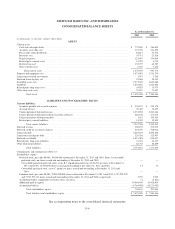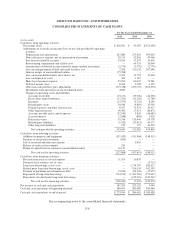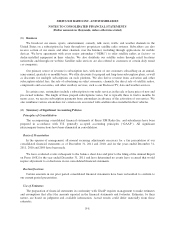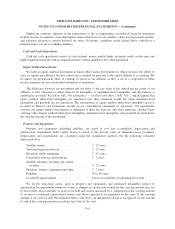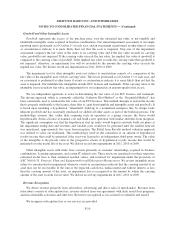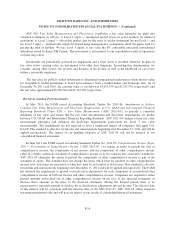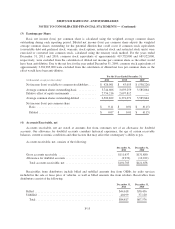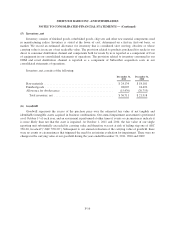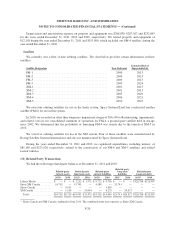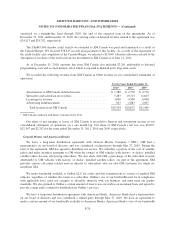XM Radio 2011 Annual Report Download - page 102
Download and view the complete annual report
Please find page 102 of the 2011 XM Radio annual report below. You can navigate through the pages in the report by either clicking on the pages listed below, or by using the keyword search tool below to find specific information within the annual report.SIRIUS XM RADIO INC. AND SUBSIDIARIES
NOTES TO CONSOLIDATED FINANCIAL STATEMENTS — (Continued)
ASC 820, Fair Value Measurements and Disclosures, establishes a fair value hierarchy for input into
valuation techniques as follows: i) Level 1 input — unadjusted quoted prices in active markets for identical
instrument; ii) Level 2 input — observable market data for the same or similar instrument but not Level 1; and
iii) Level 3 input — unobservable inputs developed using management’s assumptions about the inputs used for
pricing the asset or liability. We use Level 3 inputs to fair value the 8% convertible unsecured subordinated
debentures issued by Sirius XM Canada. This investment is not material to our consolidated results of operations
or financial position.
Investments are periodically reviewed for impairment and a write down is recorded whenever declines in
fair value below carrying value are determined to be other than temporary. In making this determination, we
consider, among other factors, the severity and duration of the decline as well as the likelihood of a recovery
within a reasonable timeframe.
The fair value for publicly traded instruments is determined using quoted market prices while the fair value
for non-publicly traded instruments is based upon estimates from a market maker and brokerage firm. As of
December 31, 2011 and 2010, the carrying value of our debt was $3,013,974 and $3,217,578, respectively; and
the fair value approximated $3,506,546 and $3,722,905, respectively.
Recent Accounting Pronouncements
In May 2011, the FASB issued Accounting Standards Update No. 2011-04, Amendments to Achieve
Common Fair Value Measurement and Disclosure Requirements in U.S. GAAP and International Financial
Reporting Standards (Topic 820) — Fair Value Measurement (“ASU 2011-04”), to provide a consistent
definition of fair value and ensure that the fair value measurement and disclosure requirements are similar
between U.S. GAAP and International Financial Reporting Standards. ASU 2011-04 changes certain fair value
measurement principles and enhances the disclosure requirements particularly for Level 3 fair value
measurements. The amendments are not expected to have a significant impact on companies that apply U.S.
GAAP. This standard is effective for interim and annual periods beginning after December 15, 2011 and will be
applied prospectively. The impact of our pending adoption of ASU 2011-04 will not be material to our
consolidated financial statements.
In June 2011, the FASB issued Accounting Standards Update No. 2011-05, Comprehensive Income (Topic
220) —Presentation of Comprehensive Income (“ASU 2011-05”), to require an entity to present the total of
comprehensive income, the components of net income, and the components of other comprehensive income
either in a single continuous statement of comprehensive income or in two separate but consecutive statements.
ASU 2011-05 eliminates the option to present the components of other comprehensive income as part of the
statement of equity. The standard does not change the items which must be reported in other comprehensive
income, how such items are measured or when they must be reclassified to net income. This standard is effective
for interim and annual periods beginning after December 15, 2011 and will be applied retrospectively. The FASB
has deferred the requirement to present reclassification adjustments for each component of accumulated other
comprehensive income in both net income and other comprehensive income. Companies are required to either
present amounts reclassified out of other comprehensive income on the face of the financial statements or
disclose those amounts in the notes to the financial statements. During the deferral period, there is no
requirement to separately present or disclose the reclassification adjustments into net income. The effective date
of this deferral will be consistent with the effective date of the ASU 2011-05. ASU 2011-05 affects financial
statement presentation only and will have no impact on our results of consolidated financial statements.
F-14


